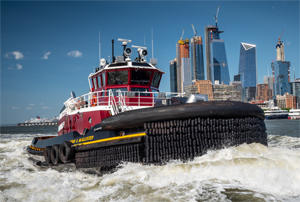It seemed fitting that McAllister Towing, synonymous with New York City, would present its biggest gun for the parade of naval vessels participating in the city’s annual Fleet Week show.
The muscular Capt. Brian A. McAllister, named for the legendary chairman of the company, led a wedge-shaped formation of McAllister tugs as they escorted an array of Navy and Coast Guard vessels from the Verrazzano-Narrows Bridge into New York Harbor’s Upper Bay.
At the Battery, Capt. Brian A. McAllister and Eric McAllister closed on USS Arlington, a San Antonio-class amphibious transport dock. McAllister docking pilot Capt. Jeffrey McAllister boarded the ship and guided Arlington up the Hudson River. At Pier 92, with Capt. Brian A. McAllister tethered to the stern and Eric McAllister to the bow, the pair turned and pushed the ship into the slip.
McAllister is building bigger and more powerful tugs to handle the ever-larger ships calling at U.S. ports. Currently, the 6,772-hp Capt. Brian A. McAllister, built by Horizon Shipbuilding at a yard now owned by Metal Shark, reigns supreme in the New York fleet.
Last June, an identical tug, Rosemary McAllister, built by Eastern Shipbuilding and named for Brian McAllister’s wife, joined McAllister’s fleet in Hampton Roads, Va. Both tugs were designed by Jensen Maritime Consultants. A third in the class, Ava McAllister, named for the daughter of company Vice President Andrew McAllister, was launched in December at Eastern Shipbuilding.
 |
|
Capt. Jesse Wynn mans the ASD controls on the Tier 4 build, which was delivered by Horizon Shipbuilding in 2017. “Everything about this boat is powerful,” he says. |
An increase in beam, from 36 feet on the EPA Tier 3 Eric McAllister to 40 feet on the Tier 4 Capt. Brian A. McAllister, was necessary to house the 2,500-gallon urea tank and equipment required for stricter emissions compliance, along with more powerful main engines.
“The power of this boat, when you bring it up you can feel it,” said mate Will Jackson.
Two 16-cylinder Caterpillar mains and Schottel z-drives provide propulsion that produces a strapping bollard pull of 80 metric tons. Caterpillar also supplied three Tier 3 118-kW gensets.
The muscle does not end in the engine room. On deck, Capt. Brian A. McAllister is fitted with a Markey 100-hp hawser winch on the bow and a 75-hp towing winch on the stern.
“The (hawser) winch is probably the best thing on this boat, but everything about this boat is powerful,” said Capt. Jesse Wynn.
Versatility is also addressed in the new class. The two winches are more than capable for escort, assist, rescue and ocean towing assignments. And an FFV1 rating qualifies the new class for LNG escort and assist work.
The additional breadth also increases stability, allowing Jensen to design a tug that utilizes the hull form in place of a skeg, an option that increases the indirect forces affecting steering and braking. The wider hull also allowed for more spacious staterooms, a larger galley and three heads.
“This boat handles very well and has lots of power,” Wynn said. “But it’s also a very comfortable boat.”
 |
 |
|
|
Crewman Ian Taylor tosses a line to a bollard as Capt. Brian A. McAllister returns to the dock during Fleet Week festivities. |
A pair of FFS fire monitors on the stern can deliver a combined 10,568 gallons per minute. The Bayonne Bridge is in the background. |
|
 |
 |
|
|
Chief engineer Rob Smith stands with one of the Caterpillar 3516E main engines. The diesels provide 80 metric tons of bollard pull. |
The Markey DESF-48 bow winch, wrapped with 800 feet of 10-inch Samson line, awaits action as the tug approaches USS Arlington. |
Capt. Brian A. McAllister specifications |
| Owner/operator: McAllister Towing and Transportation Co., New York, N.Y. Designer/builder: Jensen Maritime Consultants, Seattle, Wash./Horizon Shipbuilding, Bayou La Batre, Ala. Dimensions: L: 100’ B: 40’ D: 18’ Mission: Assist, escort and rescue tugboat Crew size: Up to seven |
|
PROPULSION CAPACITIES DECK EQUIPMENT NAVIGATION/COMMUNICATIONS FIREFIGHTING CLASSIFICATIONS |

